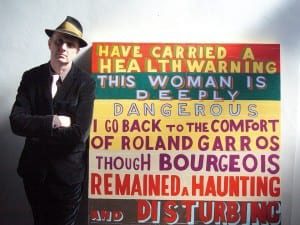The UK’s largest annual festival of visual art, Edinburgh Art Festival, returns to Scotland for its 13th edition with an extensive programme of exhibitions and events organised in partnership with some of the city’s leading cultural institutions and artist-led organisations. Alongside major presentations at the National Galleries of Scotland, Talbot Rice Gallery and Stills Gallery, a series of dynamic pop-up spaces and new public art commissions invite audiences to discover a wealth of international artistic innovation. We speak to Director Sorcha Carey about the festival’s development and its integration with the city of Edinburgh.
A: Since its establishment in 2004, Edinburgh Art Festival has grown to become the UK’s largest annual festival of visual art. How has the programme expanded over the last few years?
SC: It’s hard to believe that we are celebrating our 13th edition this year. One of the most significant developments in recent years is the growth of the festival’s events programme, with specially programmed tours, talks and performances happening nearly everyday in the festival. When Art Late was first initiated for example, it was a single evening of late night gallery openings – but this has become such a popular part of the festival programme that we are running an Art Late every week this year.
A: Held in a culturally and historically rich city, how does EAF both integrate with and challenge the environment in which it is staged?
SC: Edinburgh is a pretty special context in which to be programming art – not only does our city have an extraordinary festival history, but we are also a UNESCO World Heritage Site; and both of those contexts present opportunities to initiate conversations and dialogue. It is always enriching, I think, to have the opportunity to speak to an audience who is interested in multiple art forms, and to build conversations across disciplines – our events programme, for example, brings in audiences who are as interested in the musicians we have performing as the art that’s on display. The historic environment of Edinburgh is a constant and important presence in our festival, and our commissions programme in particular, has concentrated on opening up parts of the city that are a bit overlooked, or not generally open to the public.
A: With such a vast and dynamic programme, how is each project developed and curated? Is there a connecting theme between this year’s presentations?
SC: The vast majority of the festival’s exhibition programme is directly curated and organised by our partner galleries, which makes for a very rich and diverse offering, although (accidental) themes almost always emerge. This year, there is a really nice focus on portraiture for example, with special focuses on Alice Neel at Talbot Rice Gallery and Jo Spence at Stills Gallery, as well as a great survey show at the Scottish National Portrait Gallery exploring the history of the ‘selfie’, from Goya through to Ai Wei Wei. We also run a couple of open calls each year: one, called Platform, is to give a supported opportunity for artists at the beginning of their careers; and the other gives organisations who don’t have a year round programming presence in the city the opportunity to propose special pop up shows and events. We always get some great projects coming through this strand.
A: EAF provides a platform for new work by leading and emerging Scottish artists, with a particular emphasis on those who are developing projects in non-gallery contexts. Can you tell us more about the commissioning side of the festival?
SC: For the past five or so years, the festival has been inviting leading and emerging artists working in Scotland and internationally to develop new projects for the city. This year’s programme is titled More Lasting than Bronze, and reflects on monuments. I was very struck by the fact that while as a nation, we are remembering the centenary of WW1, one of Edinburgh’s WW1 memorials is accompanied by a sign asking visitors to respect the memorial; while other monuments have been the subject of campaigns to remove them (the statue to Cecil Rhodes in Oxford for example).The programme includes seven new works by Bani Abidi, Roderick Buchanan, Graham Fagen, Sally Hackett, Jonathan Owen, Ciara Phillips, and Olivia Webb, all of them reflecting in different ways on who and what societies choose to remember.
A: As the Director of EAF, which shows and events are you most excited by?
SC: With over 50 exhibitions across the city, I think what excites me most about the festival each year is the opportunity it presents to spend five weeks immersing myself in amazing art. Our partner venues reflect such a broad range of possible forms and contexts for presenting art, from national institutions through to more temporary venues in unusual contexts – each year, I find myself discovering the work of an artist that I am less familiar with, as well as revisiting old favourites.
Edinburgh Art Festival, until 28 August, venues across Edinburgh.
Find out more: www.edinburghartfestival.com.
For the latest news in contemporary art and culture, follow us on Facebook, Twitter and Instagram.
Credits
1. Jonathan Owen, Installation view of Untitled, 2016. Courtesy of Ingleby Gallery.





